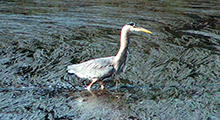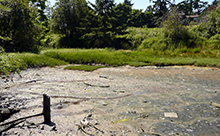 One of the most important ecosystems in the Gorge is the eelgrass that covers about 80 hectares of the seabed. Eelgrass grows in soft sediment and provides sheltered habitat for fish and a complex food web of other marine life. Their rhizomes (branching roots) are important for trapping sediments and reducing shoreline erosion.
One of the most important ecosystems in the Gorge is the eelgrass that covers about 80 hectares of the seabed. Eelgrass grows in soft sediment and provides sheltered habitat for fish and a complex food web of other marine life. Their rhizomes (branching roots) are important for trapping sediments and reducing shoreline erosion.
Rocky subtidal benthic communities are groups of plants and animals that inhabit rocky areas of the ocean floor in the subtidal zone. They include aggregations of sedentary sponges, tunicates, bryozoans and cnidarians (e.g. anemones). Mussels, sea urchins, gastropods (e.g. snails and limpets), and crabs are also common. Some of the largest such communities in the CRD harbours thrive in the high current areas of Gorge, where tidal currents sweep through with a steady supply of food (e.g. plankton, detritus) and oxygen.
Kelp beds form another important ecosystem in the Gorge. Kelp grows in areas where currents or upwelling supply nutrients, such as along the narrow area between the Selkirk Trestle and Gorge Narrows. It provides important habitat and food for fish and marine invertebrates.

There are a few estuaries in the Gorge, including at the mouth of Cecelia, Colquitz, Craigflower and Hospital creeks. Estuaries typically consist of intertidal mud flats and a fringe of salt marsh vegetation, providing habitat for burrowing animals, and feeding grounds for birds.
In the high current areas of the Gorge, especially at the Narrows, there is an ecosystem typically found in areas with much higher wave exposure. The animals and plants found there include sponges, bryozoans, sea squirts and other sedentary (attached) filter-feeders that rely on the swift tidal currents to deliver their microscopic food.